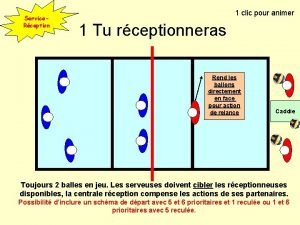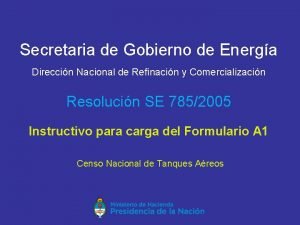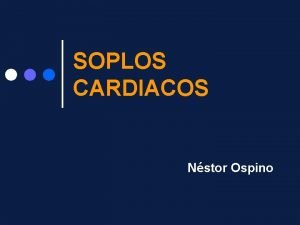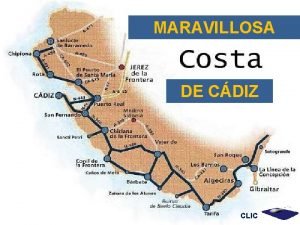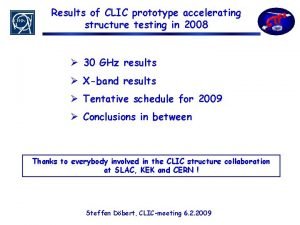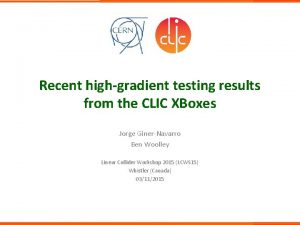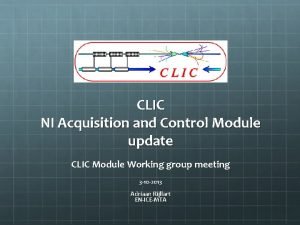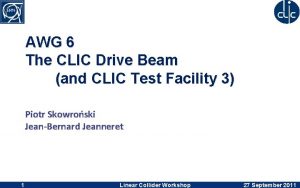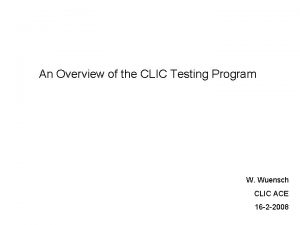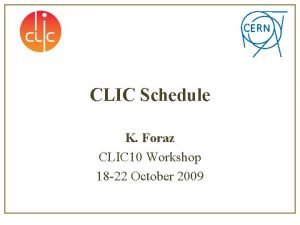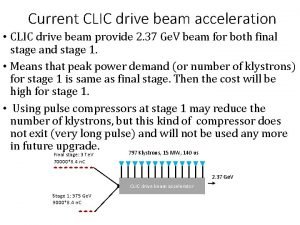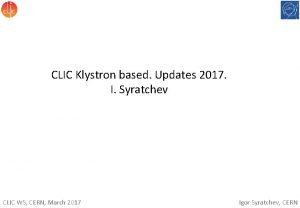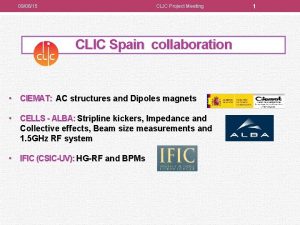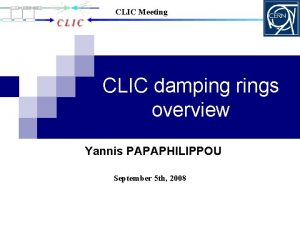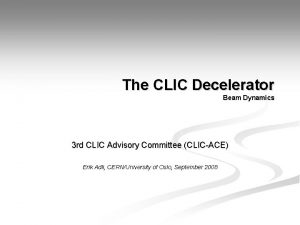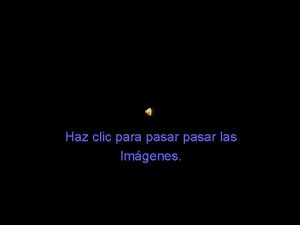2010 TESTING PROGRAM AND RESULTS FOR THE CLIC


























- Slides: 26

2010 TESTING PROGRAM AND RESULTS FOR THE CLIC PETS X-BAND WORKSHOP ON RF STRUCTURES, BEAM DYNAMICS AND SOURCES 2 nd December 2010 Alessandro Cappelletti for the CLIC team with great support from the SLAC team: V. Dolgashev, Lewandowski, S. Tantawi, S. Weatherly, J. Zelinski J.

A fundamental element of the CLIC concept is two-beam acceleration, where RF power is extracted from a high-current and low-energy beam in order to accelerate the low-current main beam to high energy. Drive beam Main beam PETS Accelerating structures RF power PETS

PETS specific features: Electric field RF power density 1. Big aperture, high Vg, low surface E-field 2. High peak RF power (135 MW) 3. High current (100 A) 4. HOM damping through 8 slots 5. Special coupler with choke 6. Milling technology for fabrication 7. Body assembly with clamping PETS parameters Surface electric field Surface magnetic field §Frequency = 11. 9942 GHz §Aperture = 23 mm §Active length = 0. 213 (34 cells) § Period = 6. 253 mm (900/cell) § Iris thickness = 2 mm §Slot width = 2. 2 mm § R/Q = 2222 Ω/m § V group= 0. 459 C § Q = 7200 §E surf. (135 MW)= 56 MV/m § H surf. (135 MW) = 0. 08 MA/m (ΔT max (240 ns, Cu) = 1. 8 C 0)

RF power sources PETS testing program Drive beam External RF power source RF high power source RF power in RF power out Drive beam ASTA (SLAC) Objective: to understand the limiting factors for the PETS ultimate performance and breakdown trip rate. • Access to the very high power levels (300 MW) and nominal CLIC pulse length. • High repetition rate – 60 Hz. CTF 3 (CERN + Collaborations) Two beam test stand (CERN + Collaborations) Objective: to demonstrate the reliable production of the nominal CLIC RF power level through the deceleration of the drive beam. Test beam line (CERN + Collaborations) Objective: to demonstrate the stable, without losses, beam transportation in a presence of strong (50%) deceleration.

The first scaled (11. 424 GHz) full CLIC PETS version with damping slots and damping material. load Low RF power measurements Reflection Transmission June 2010

PETS testing @ ASTA, SLAC The ASTA pulse compressor with variable delay lines Experimental area ASTA layout Uncompressed arm Gate valve ASTA is a new generation general purpose test stand, which will allow processing the various types of the high power RF equipment at X-band. The facility can provide a very versatile pulse length and power level. RF pulse @ power in the ASTA compressed arm Rf Phase shifter 3 d. B hybrid SLED II with variable length and iris reflection CLIC PETS Two klystrons 50 MW@1. 5 us PETS installed into the ASTA bunker at SLAC The ASTA pulse compressor with variable iris PETS ready for shipping to SLAC July 2010

General remarks Ø 275 hours of PETS high power testing were overall accumulated. Ø In order to obtain breakdown statistics, the PETS was running at a fixed power level of 142 MW and pulse length 266 ns (18% higher pulse energy than in CLIC) for 125 hours. Ø The whole RF network system in ASTA was also being conditioned at the same time, which somewhat limited the power production stability at high power levels due to the vacuum interlocks trips in the waveguide circuit.

PETS processing history PETS/ASTA processing period Average and peak power distributions BD statistics accumulation period (fixed power level) CLIC target pulse In total: 5. 9 x 107 pulses 90 breakdowns 266 ns CLIC target Peak power Avg power Energy BD CLIC target 133 ns Typical RF pulse shape in ASTA during the last 125 hours of operation

Breakdowns in the PETS The breakdown acquisition signals: Two typical breakdown events in the PETS (raw data) - Reflected and transmitted power - Vacuum controllers - Faraday cups mounted at both PETS extremities. Pre-breakdown pulse Reflected RF in Vacuum gauge F 1 27 d. B RF out Transmitted Directional coupler Faraday cup PETS Breakdown pulse F 2 ‘hard’ Processing strategy: In case of breakdown, the RF power is shut down on the next pulse and restarted/ramped up after a few seconds, vacuum interlocks permitting. F 2 ‘soft’ F 1 1. ‘Hard’ event. The variation in reflection is measurable. 2. ‘Soft’ event. The variation in reflection is negligible.

Breakdown locations 266 ns All breakdowns Type-2 (input) Type-1 (output) 1. 2. 3. In general, the breakdowns were grouped into two types of events with respect to the Faraday cups signals. We suggested that this can help to identify the breakdown location by correlating the arrival times and amplitudes of the two. Following, “type-1” events are located close to the output coupler and “type-2” are closer to the input coupler. We also observed that “hard” events are mostly associated with “type-1” events. Type-1 (output) F 2 Type-2 (input) Total breakdowns Type-1 Type-2 F 1 53 23 30

‘hard’ events examples Missing Energy None of the registered breakdowns showed traces of pulse shortening (missing energy). Any of these events will be practically undetectable in the CLIC environment. ‘soft’ events examples

PETS breakdown trip rate BDR statistics accumulation testing period (142 MW x 266 ns). CLIC target Peak power Avg power Energy BD All registered events All breakdowns During ~125 hours of testing, 15 events were logged into breakdown counter following Faraday cups signals. Six of them were discarded from breakdown statistic due to the late (in time) appearance of the dark current and thus irrelevant for CLIC. Examples of discarded events

PETS breakdown trip rate Portion of the statistical distribution contributing to the BDR calculation CLIC target 1. 55 x 107 pulses 1. 2. 3. 1. 55 x 107 pulses were accumulated in a 125 hours run with fixed peak power and pulse length. 8 PETS breakdowns were identified giving a breakdown rate of 5. 3 x 10 -7/pulse/PETS. Most of the breakdowns were located in the upper tail of the distribution and happened at earlier stage of the run, which makes the integrated BDR estimate rather conservative. 4. During the last 80 hours no breakdowns were registered giving a BDR <1. 2 x 10 -7/pulse/PETS counting only the pulses with average power higher than the CLIC nominal.

Summary 1. The complete feasibility demonstration of the power production in CLIC will require PETS operation with 100 A drive beam (partially covered in CTF 3 – 30 A). However these experiments will be more focused on the beam dynamics and machine protection issues (partially covered in TBL). 2. The feasibility of the PETS operation at a peak RF power level ~7% higher and with RF pulses ~10% longer compared to the CLIC requirement was successfully demonstrated in klystron driven experiments at SLAC. 3. The tests at a fixed power level were stopped, when the measured breakdown trip rate went close enough to CLIC specification: 1 x 10 -7/pulse/PETS. In our case it was after 80 hours of operation without any breakdown (BDR <1. 2 x 10 -7/pulse/PETS ). 4. The demonstration has been done in more demanding environment then needed for CLIC - with extra input coupler and uniform RF power distribution along the structure (>50% of breakdowns happened closer to the input coupler).

Future plans 1. Further testing of the PETS at a CLIC RF power level and measured breakdown trip rate would require enormous operational time (hundreds of hours) to provide reasonable statistic in order to improve the BDR measurement accuracy. Together with tight ASTA experimental schedule this approach looks rather inefficient. 2. A more reasonable approach is moving towards even higher power levels: 180 -200 MW. It will potentially allow for a shorter testing time and could result in more understanding about PETS ultimate performance. To perform these tests, ASTA itself should be processed accordingly, to able to operate stable at such high power levels.

Two-beam Test Stand Prospects • Unique and versatile facility for demonstrating the CLIC two beam accelerating technology – two-beam operation • high power drive-beam [~110 Me. V, ~30 A] • high quality probe-beam [~140 Me. V, ~0. 5 A] – excellent beam diagnostics – easy access & flexibility for future upgrades • Excellent test possibilities – power production & accelerating structures • beam kick • beam dynamics effects – full CLIC module • beam-based alignment

TBTS is the test area in CLEX, where feasibility of the CLIC two beam acceleration scheme is…already demonstrated (not yet at a nominal 100 MV/m accelerating gradient).

RF power production with re-circulation Different scenarios of the drive beam generation in the CTF 3 • In order to demonstrate the nominal CLIC power level and pulse length and yet low current, it was decided to implement a different PETS configuration – PETS with external re-circulation. CTF 3 #1 DL DBA CTF 2 CR Round trip efficiency: 80% Round trip delay: 26 ns <30 A CLEX TBTS Variable phase shifter #2 To the Load Variable Splitter (coupling: 0 1) PETS output Drive beam PETS input 14 A #3 4 A • To compensate for the lack of current, the active TBTS PETS length was significantly increased: from the original 0. 215 m to 1 m. Operation mode #1 #2 #3 CLIC Current, A <30 14 4 101 Pulse length, ns 140 <240 <1200 240 Bunch Frequency, GHz 12 12 3 12 <280 61 5 135 PETS power (12 GHz), MW Fully equipped 1 m long TBTS PETS Variable RF phase shifter and splitter

Ø In itself, re-circulation provides additional opportunity for the complimentary beam diagnostic and potentially for the RF breakdown characterization. Ø Normally, the breakdown event de-synchronize the re-circulation conditions and thus quench the power production protecting the structure. Model with time variable coupling and phase (V. Ziemann) Model with constant coupling and phase (E. Adli) Event with breakdown coupling phase

TBTS tests in 2009 PETS processing history example 3 weeks later beginning Two Beam Test Stand (TBTS) Current, Ax 10 beginning Power, MW 3 weeks later At the end of 2009, the PETS was reliably producing ~60/70 MW Drive beam predicted PETS tank with re-circulation RF circuit installed in TBTS test area (October 2008) measured

TBTS in 2009 Phase shifter’s 3 d. B hybrid ~λ/2 The RF signal analysis indicated that in most of the cases breakdown activity was associated with feedback loop and not the PETS itself. Visual inspection of the attenuator’s and phase shifter’s hybrid bodies showed serious breakdown damages and confirmed that these devices were limiting the power production performance. Attenuator’s 3 d. B hybrid

TBTS hardware upgrade earlier in 2010 The brand new components Accelerating structure tank PETS tank 1. The brand new waveguide components made by GYCOM (Russia) went through the complete cleaning procedure: - Chemical - Hydrogen firing - Vacuum firing and were installed into the PETS re-circulation loop. 2. The TD 24 accelerating structure tank was installed into TBTS area. Ready for the 2 -beam operation. Two beam module in CLIC If any problem with attenuator and phase shifter in a future, we have prepared back-up solution with a fixed 3 d. B splitter

TD 24_vg 1. 8_disk accelerating structure in TBTS Ø 24 regular + 2 coupler cells with damping features ØL acc = 200. 0 mm (regular cells) Øfilling time = 65 ns Ø 42 MW input power for 100 MV/m (unloaded) (57 MW loaded) Average unloaded gradient of 100 MV/m Alexey Grudiev

2010 CTF 3 schedule The fire accident with klystron modulator#13 caused a 3 -month delay into CTF 3 operational schedule. Beam into the PETS Pulse Forming Network after fire The first drive beam arrived to TBTS in early August 2010.

PETS rapidly (~ few x 105 pulses) reached record peak RF power levels above 300 MW. It reliably produces RF power which is sufficient for demonstration of the >100 MV/m acceleration in a two beam experiment with TD 24_vg 1. 8_disk structure. Example of the 3 consecutive pulses in the TBTS (power coupled back is 65%) PETS output Power, MW 18. 10. 2010 Measured Predicted Structure input CLIC target pulse reflection I, A Breakdown in 2 nd attenuator Power, MW Drive beam current

Power production history in TBTS Two-beam acceleration in TBTS/CTF 3 Latest results (18. 10. 2010): 20. 02 Me. V gain/structure Demonstrated accelerating gradient: 100*20. 02/21. 7 = 92. 3 MV/m
 Oxfordenglishtesting.com
Oxfordenglishtesting.com Positive testing and negative testing
Positive testing and negative testing Static testing and dynamic testing
Static testing and dynamic testing La haut sur la lune grand saint nicolas
La haut sur la lune grand saint nicolas Sales double entry
Sales double entry Diccionario clic
Diccionario clic Dead clic
Dead clic 1 clic reception
1 clic reception Ingreso al sistema web res. 1102-404 y res. 785
Ingreso al sistema web res. 1102-404 y res. 785 Clic paris emeraude
Clic paris emeraude Clic mesosistolico
Clic mesosistolico Clic
Clic Imagenes de clic
Imagenes de clic Clic
Clic Cern clic
Cern clic Clic sequr citoyen
Clic sequr citoyen Clic music
Clic music Rey orozco
Rey orozco Domain testing in software testing methodologies
Domain testing in software testing methodologies Motivational overview of logic based testing
Motivational overview of logic based testing Data flow testing strategies in software testing
Data flow testing strategies in software testing Globalization testing
Globalization testing Functional testing vs unit testing
Functional testing vs unit testing Language testing
Language testing Control structure testing in software testing
Control structure testing in software testing Decision table testing in software testing
Decision table testing in software testing Decision table based testing
Decision table based testing







